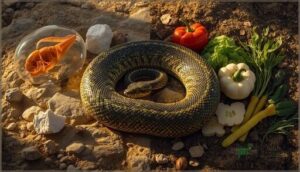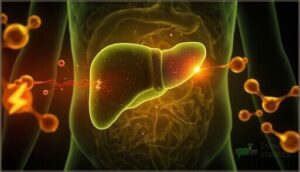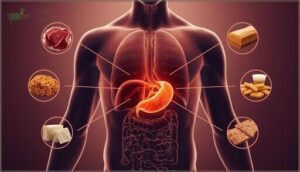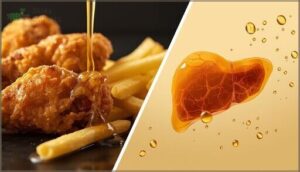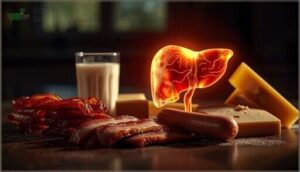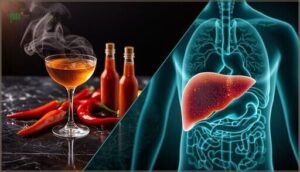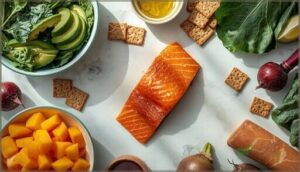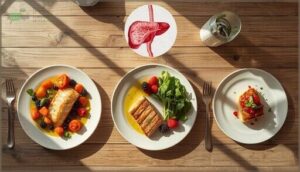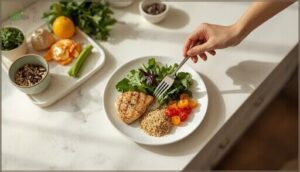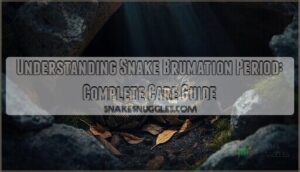This site is supported by our readers. We may earn a commission, at no cost to you, if you purchase through links.
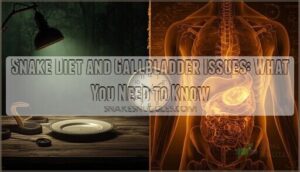
The snake diet’s extreme fasting and feast approach creates a perfect storm for your gallbladder—prolonged fasts allow bile to stagnate and crystallize, while sudden high-fat meals force a struggling organ to work overtime.
If you’re dealing with gallbladder issues or considering this controversial eating pattern, understanding how it impacts bile production and stone formation can help you avoid painful complications and make choices that actually support your digestive health.
Table Of Contents
- Key Takeaways
- How Diet Impacts Gallbladder Health
- What is The Snake Diet?
- Risks of Snake Diet for Gallbladder Issues
- Common Gallbladder Symptoms and Triggers
- Foods to Avoid for Gallbladder Health
- Best Foods for Gallbladder Support
- Safe Eating Styles for Gallbladder Problems
- Managing Gallbladder Health After Surgery
- Top Gallbladder Diet Cookbooks and Plans
- Frequently Asked Questions (FAQs)
- Conclusion
Key Takeaways
- The Snake Diet’s extreme fasting windows (48-96 hours) cause bile to stagnate and thicken in your gallbladder, creating the perfect conditions for gallstone formation and sludge buildup that can lead to painful attacks.
- Breaking prolonged fasts with high-fat meals—like fatty meats, oils, and cheese commonly eaten on the Snake Diet—forces your gallbladder to contract suddenly and intensely, triggering severe pain and potentially dangerous complications if stones are present.
- Rapid weight loss from extreme calorie restriction (as low as 3,500 calories weekly) increases gallstone risk by 10-12% within just 8-16 weeks, as it disrupts bile chemistry and slows gallbladder emptying.
- Evidence-based eating patterns like Mediterranean and DASH diets reduce gallstone risk by about 35% through regular meals, adequate fiber (25-30 grams daily), healthy fats, and consistent eating schedules that keep bile flowing smoothly without overwhelming your gallbladder.
How Diet Impacts Gallbladder Health
Your gallbladder doesn’t work alone—it needs the right fuel to do its job well. What you eat can either support healthy digestion or set the stage for painful problems down the road.
Let’s look at three key ways your diet shapes your gallbladder health.
The Gallbladder’s Role in Digestion
Your gallbladder might be small—about the size of a pear, but it plays a mighty role in helping you digest the foods you eat every day.
This pouch tucked under your liver stores bile, a digestive fluid your liver makes. When fat enters your digestive system, your gallbladder contracts and releases bile to break down those fats so your body can absorb essential nutrients properly.
Effects of Dietary Fat and Fiber
What you eat—especially the balance of fat and fiber—can make a real difference in how smoothly your gallbladder does its job. High-fat foods trigger more bile secretion, which can overwhelm a struggling gallbladder and spark painful attacks.
On the flip side, fiber helps your digestive system run smoothly and may lower your risk of gallstone formation. A balanced intake of low-fat meals with plenty of fiber gives your gallbladder the support it needs to function without unnecessary strain.
Diet and Gallstone Formation
The connection between diet and gallstones is backed by solid research. Eating over 1,960 calories daily—especially from high-fat foods and refined sugars—more than doubles your risk of developing gallstones. Rapid weight loss on extreme diets can actually trigger stone formation, with one study showing a quarter of dieters developed gallstones after just eight weeks. But here’s the good news: protective patterns like Mediterranean-style eating can cut your risk by about 35%. Specific nutrients matter too—vitamin C, fiber, and healthy fats from fish and nuts all help keep bile chemistry balanced and your gallbladder happy. Obesity increases the likelihood of developing gallstones, especially in women.
- Calorie intake above 1,960 daily doubles gallstone risk
- High saturated fat consumption promotes cholesterol buildup in bile
- Very-low-calorie diets trigger gallbladder issues in 25% of dieters
- Mediterranean diets reduce symptomatic gallbladder attack risk by 35%
- Fiber and vitamin C protect against gallstone formation
What is The Snake Diet?
You may have heard about the Snake Diet making bold promises online. This extreme fasting approach has gained attention, but it’s important to understand what it actually involves before considering it—especially if you have gallbladder concerns.
Let’s look at the basics of this diet and how it compares to eating patterns that support gallbladder health.
Snake Diet Basics and Claims
The Snake Diet isn’t your typical eating plan—it’s an extreme fasting protocol created by Cole Robinson, who has no formal medical or nutrition credentials. Here’s what sets it apart from standard approaches to gallbladder health:
| Snake Diet Feature | What It Means for You |
|---|---|
| Fasting Windows | 48–96 hours between meals |
| Eating Windows | Just 1–2 hours to consume food |
| Weekly Meals | Only 1–3 meals per week |
| Caloric Restriction | As low as 3,500 calories weekly |
During fasting periods, you’re limited to “Snake Juice”—an electrolyte drink mixing water with salts and minerals. Robinson claims this diet can cure diabetes and inflammation, but no peer-reviewed research backs these claimed benefits.
The extreme caloric restriction raises serious concerns for gallbladder disease management. Prolonged fasting and irregular eating patterns can worsen gallbladder issues rather than support gallbladder health. This diet promotes intense intermittent fasting, involving a low-carb meal only once every few days.
Typical Foods and Eating Patterns
When you’re allowed to eat on the Snake Diet, the food choices can be just as shocking as the fasting schedule itself. Followers consume high-fat foods like fatty meats, eggs, and butter during their brief one-to-two-hour eating windows.
This eating pattern conflicts with dietary changes recommended for gallbladder issues, since these foods to avoid for gallbladder health can trigger painful attacks. Your meal frequency drops to just once or twice weekly, creating irregular eating schedules that disrupt normal bile flow and increase food triggers.
Snake Diet Vs. Gallbladder-Friendly Diets
Unlike gallbladder-friendly eating plans, the Snake Diet creates a perfect storm for gallbladder issues through extreme dietary changes. Here’s the critical diet comparison:
- Fasting Risks: Snake Diet’s 48-96 hour fasts promote bile stasis, while gallbladder health requires regular meals to keep bile flowing
- Fat Content: Snake Diet emphasizes high-fat foods that trigger symptom attacks versus low-fat gallbladder diet recommendations
- Fiber Intake: Snake Diet lacks the 25-30 grams daily fiber that protects against gallstone formation
- Weight Loss Speed: Rapid weight loss increases gallstone risk threefold compared to gradual, safe approaches
- Meal Patterns: Irregular eating disrupts bile secretion, while consistent mealtimes support proper gallbladder function
Mediterranean and DASH diets remain evidence-based alternatives that actually protect your gallbladder.
Risks of Snake Diet for Gallbladder Issues
The Snake Diet’s extreme approach can create serious problems for your gallbladder. Extended fasting periods, heavy fat intake, and rapid weight loss all put extra stress on this small organ.
Let’s look at three specific ways this diet can trigger gallbladder issues.
Fasting and Bile Stasis
Extended fasting can make your gallbladder sluggish, causing bile to sit and thicken like syrup left in a bottle—and that stagnant bile creates the perfect environment for gallstones to form. When you skip meals for long stretches, your gallbladder doesn’t empty properly, which increases your risk of gallbladder symptoms and attacks.
Some doctors prescribe ursodeoxycholic acid to help prevent stones during rapid weight loss, but the best approach is avoiding extreme fasting lengths altogether.
High-Fat Meals and Gallbladder Attacks
Breaking your fast with a heavy, greasy meal is like tossing a match into dry kindling—your gallbladder contracts hard and fast to release bile for all that fat, and if you have gallstones or sludge, that sudden squeeze can trigger intense pain within minutes.
Breaking your fast with greasy meals triggers intense gallbladder contractions that can spark sudden, severe pain if stones are present
The Snake Diet’s typical refeeding foods—fatty meats, oils, and cheese—are exactly the dietary triggers that provoke gallbladder attacks. You’ll experience classic attack symptoms like sharp upper-right abdominal pain, nausea, and sometimes vomiting as your gallbladder struggles with fat digestion and bile production.
Rapid Weight Loss and Gallstone Risk
Dropping weight too fast—more than 1.5 kg per week—triggers a dangerous chain reaction in your gallbladder. Rapid weight loss increases cholesterol saturation in bile and slows gallbladder emptying, creating the perfect storm for gallstones and biliary sludge.
Studies show 10–12% of people on very low-calorie diets develop gallstones within 8–16 weeks, and bariatric surgery patients face even higher rates—over 30% within 18 months.
Weight cycling makes things worse, repeatedly altering your bile chemistry and raising gallbladder attack risk with each yo-yo cycle.
Common Gallbladder Symptoms and Triggers
Your gallbladder can send you warning signals when something’s not right. Learning to recognize these symptoms helps you respond quickly and avoid complications.
Let’s break down the key signs, common trigger foods, and practical ways to identify what sets off your symptoms.
Signs of Gallbladder Distress
Your gallbladder might be sending up warning signs right now, and knowing what to watch for can help you catch problems before they spiral out of control. The most common symptom of gallbladder issues is sharp abdominal pain in your upper right side, often spreading to your shoulder or back—that’s referred pain.
You might also experience nausea symptoms, vomiting, bloating, and digestive issues after eating fatty meals. Jaundice signs like yellowing skin signal a gallbladder attack needs immediate attention.
Foods That Commonly Cause Attacks
Certain foods act like landmines for your gallbladder, setting off painful attacks within hours of eating them. High-fat foods like fried chicken, fatty meats, and full-fat dairy products top the list of dietary triggers for gallbladder issues.
Processed meats, sugary drinks, and anything deep-fried can overwhelm your gallbladder’s ability to process bile. These foods to avoid for gallbladder health share one thing: they force your gallbladder to work overtime, often leading to a gallbladder attack that sends you reaching for pain relief.
How to Track Your Triggers
Keeping a food diary for a few weeks can reveal exactly which foods turn your gallbladder into a pain factory. Write down everything you eat, the portion size, and how you cooked it.
Then rate your symptoms of gallbladder issues on a simple scale—mild discomfort to full-blown attack.
Don’t forget to track hydration levels too, since water intake affects bile flow and can influence your dietary triggers for gallbladder issues.
Foods to Avoid for Gallbladder Health
When your gallbladder is struggling, certain foods can turn a quiet day into a painful ordeal. Knowing what to skip isn’t about deprivation—it’s about giving your body a fighting chance to heal.
Let’s look at the biggest troublemakers that can trigger gallbladder attacks.
Saturated Fats and Fried Foods
When saturated fats and fried foods hit your system, your gallbladder has to work overtime—and that extra effort can trigger intense pain if you’re already dealing with gallstones or inflammation. These high-fat foods—think butter, lard, and restaurant fried foods—force your gallbladder to release extra bile.
Hidden saturated fats lurk in many processed items too. Instead, try healthy fat swaps like olive oil when making cooking oil choices to ease fatty food cravings without the risk.
Processed Meats and Full-Fat Dairy
Bacon, hot dogs, and whole milk might seem harmless, but they pack the same gallbladder punch as fried foods—high in saturated fat and cholesterol that can set off painful attacks.
Processed meats and full-fat dairy products are foods to avoid for gallbladder health because of:
- Saturated fat levels that trigger bile release
- Sodium content that stresses your digestive system
- Meat processing methods that concentrate fats
- Dairy intolerance compounding gallbladder pain
Watch your portion sizes even with leaner options.
Refined Carbohydrates and Sugary Drinks
White bread, pastries, and soda don’t contain fat, but they still stir up trouble for your gallbladder by spiking blood sugar and promoting inflammation. When you eat refined carbohydrates and sugary drinks regularly, you’re setting yourself up for insulin resistance and weight gain—two factors that increase your risk of gallbladder problems.
| Food Type | Why It’s Risky | Better Choice |
|---|---|---|
| White bread, pastries | Spike blood sugar, cause inflammation | Whole grain bread, oatmeal |
| Sodas, energy drinks | Promote weight gain, insulin resistance | Water, herbal tea |
| Candy, cookies | Increase cholesterol in bile | Fresh fruit, unsweetened snacks |
| Sweetened cereals | Lack fiber, stress digestion | High-fiber cereal, plain yogurt |
| Fruit juices | Concentrated sugar without fiber | Whole fruits with skin |
The effects of sugar-sweetened beverages go beyond empty calories—they actually change your bile chemistry and make gallstone formation more likely.
Alcohol and Spicy Foods
If you’ve been wondering whether your happy hour or love of hot sauce could be sabotaging your gallbladder, the answer is a bit more nuanced than you might expect. Moderate alcohol may actually reduce gallstone risk, though excessive drinking increases inflammation and gallbladder issues.
Spicy foods don’t usually trigger attacks directly, but they can worsen existing symptoms like nausea or pain. The key is moderation and paying attention to how your body responds.
Best Foods for Gallbladder Support
When your gallbladder needs extra care, choosing the right foods can make all the difference. The good news is that you don’t have to give up flavor or satisfaction to support your digestive health.
Let’s look at the best food choices that can help keep your gallbladder happy and reduce your risk of painful attacks.
High-Fiber Fruits and Vegetables
Loading up on fiber-rich produce isn’t just good for your gut—it’s one of the best moves you can make for your gallbladder. Think apples, berries, leafy greens, carrots, and broccoli.
These fruits and vegetables deliver the fiber your digestive health craves while supporting gallbladder function. Start with small portion sizes and drink plenty of water to help your body absorb those fiber benefits without discomfort.
Lean Proteins and Healthy Fats
Your gallbladder doesn’t need fatty bacon or butter-loaded meals—it needs protein that won’t send it into overdrive. Choose lean proteins like skinless chicken, white fish, and turkey.
Pair them with healthy fats from olive oil, avocados, or fatty fish rich in omega-3s. These support gallbladder health without triggering attacks.
Use cooking methods like baking or grilling, and keep portion control in mind—smaller, balanced meals work best for a low-fat diet.
Whole Grains and Hydration
Filling your plate with whole grains and water might sound boring, but these two basics are your gallbladder’s best defense against pain and inflammation. Whole grains like oatmeal, brown rice, and quinoa deliver fiber benefits that keep bile flowing smoothly and support digestive health.
Pair smart grain choices with proper hydration levels—aim for at least eight glasses daily—to prevent gallstone formation and maintain balanced meals that won’t trigger attacks.
Safe Eating Styles for Gallbladder Problems
If you’re dealing with gallbladder problems, you don’t have to figure out what to eat on your own. There are proven eating styles that can help protect your gallbladder and reduce your symptoms.
Let’s look at three approaches that work well for people with gallbladder issues.
Mediterranean and DASH Diet Benefits
Two evidence-based dietary guidelines for gallbladder health stand out: the Mediterranean diet and the DASH diet. Research shows both approaches dramatically lower your risk of gallstone disease and support overall gallbladder function. Here’s what makes these healthy eating styles so protective:
- High fiber intake from fruits, vegetables, legumes, and whole grains keeps bile flowing smoothly and reduces gallstone formation
- Healthy fats like olive oil and plant-based options support gallbladder emptying without triggering attacks
- Lean proteins from fish and poultry minimize saturated fat that stresses your gallbladder
- Low sodium and sugar reduce inflammation and cardiometabolic risks linked to gallbladder problems
- Diet adherence across diverse populations shows consistent benefits regardless of age, sex, or existing health conditions
Men following the Mediterranean diet showed a 34% lower risk of symptomatic gallstone disease, while the DASH diet offered similar protection with a 34% risk reduction. Both patterns emphasize key components that give your gallbladder the support it needs while addressing underlying metabolic factors. These aren’t restrictive plans—they’re sustainable approaches that protect your digestive system and overall health.
Low-Fat Cooking Methods
Choosing how you cook matters just as much as what you eat when you’re protecting your gallbladder from unnecessary stress. These techniques minimize fat while maximizing flavor:
| Cooking Method | Best For | Why It Works |
|---|---|---|
| Steaming vegetables | Broccoli, carrots, green beans | Preserves nutrients without adding fat |
| Baking techniques | Chicken breast, sweet potatoes | Creates crispy texture using minimal oil |
| Grilling lean proteins | Fish, turkey, tofu | Drains excess fat naturally |
Air frying gives you that satisfying crunch without deep-frying’s heavy fat load. Poaching fish in broth keeps it moist while supporting healthy fat digestion.
These low-fat cooking methods for digestion help your body break down meals without triggering gallbladder contractions that lead to pain.
Balanced Meal Planning and Portion Control
Smart meal planning turns those healthy cooking methods into a sustainable rhythm that keeps your gallbladder calm and your energy steady throughout the day. Portion size awareness prevents overwhelming your system with too much fat at once.
Eating smaller meals every three to four hours—using balanced diet benefits and meal timing strategies—fosters steady bile flow without triggering attacks. This mindful eating habit creates sustainable lifestyle changes that protect your gallbladder health while keeping you satisfied.
Managing Gallbladder Health After Surgery
After gallbladder removal, your body adjusts to life without this organ, but your digestion doesn’t stop working—it just needs a little guidance.
You’ll want to ease back into eating with some smart strategies that help your system adapt.
Here’s what you need to focus on to feel your best after surgery.
Post-Cholecystectomy Diet Tips
After gallbladder removal, your digestive system needs time to adjust to continuous bile flow. Medical guidelines suggest limiting dietary fat to under 30% of daily calories initially, while prioritizing hydration—aim for 8 to 10 cups of water daily.
Here are essential post-surgery dietary guidelines for healthy eating:
- Start with clear liquids for 1–2 days, then progress to soft, bland foods like white rice and bananas before resuming normal meals.
- Keep fat reintroduction gradual by avoiding fried foods and fatty sauces, testing your tolerance slowly with small amounts.
- Increase gradual fiber intake using whole grains and oats to normalize digestion without triggering cramping or diarrhea.
- Control portion sizes by eating small, frequent meals rather than overwhelming your system with large servings.
- Practice lactose avoidance temporarily if you notice sensitivity, switching to lactose-free dairy products until your gut adapts.
These dietary restrictions support managing gallbladder health through diet while minimizing discomfort during recovery.
Reducing Post-Surgery Digestive Symptoms
Even with careful eating after surgery, digestive symptoms like diarrhea, bloating, and cramping can catch you off guard in the weeks ahead. Your digestion needs support through gentle symptom management strategies.
Try eating smaller meals throughout the day to ease the load on your system. Boost fiber intake slowly and follow hydration strategies by sipping water between meals.
Consider probiotic use or enzyme supplements if postsurgery dietary guidelines aren’t controlling your discomfort completely.
Importance of Fiber and Hydration
Fiber and hydration work like a tag team to keep your digestive system running smoothly after gallbladder surgery. Fiber benefits include bowel regularity and post-surgery by preventing diarrhea and bloating.
Hydration impact matters just as much—water helps your body process bile efficiently and aids gallstone prevention. Together, they’re your best allies for digestive health and long-term gallbladder health.
Top Gallbladder Diet Cookbooks and Plans
Finding the right cookbook can make all the difference when you’re managing gallbladder issues or adjusting to life after surgery. The right recipes help you avoid trigger foods while still enjoying satisfying meals.
Here are some popular cookbooks and meal plans designed specifically for gallbladder health.
1. No Gallbladder Diet Cookbook Recipes
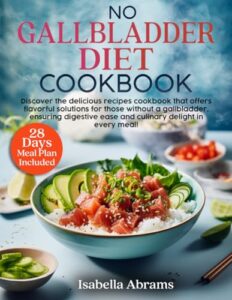
When you’re dealing with gallbladder problems, having a reliable cookbook makes all the difference. The No Gallbladder Diet Cookbook Recipes offers over 200 meals designed specifically for life after gallbladder removal or gallbladder disease.
You’ll find recipe variety covering breakfast, lunch, dinner, snacks, and even desserts—all with a nutritional focus on low-fat, high-fiber foods that support digestive wellness.
The cookbook includes structured meal planning with a 30-day guide that takes the guesswork out of your daily choices. Best of all, accessibility meals means simple ingredients you can find at any grocery store, helping you avoid foods to avoid for gallbladder health without sacrificing flavor.
Best For: Anyone recovering from gallbladder removal or managing gallbladder issues who wants simple, digestive-friendly recipes with clear meal plans and easy-to-find ingredients.
- Over 200 recipes covering all meals from breakfast to desserts, with a 30-day structured meal plan that eliminates daily guesswork and supports consistent low-fat, high-fiber eating.
- Focuses on nutrient-dense, easy-to-digest foods like lean proteins, whole grains, and vegetables while clearly avoiding common trigger foods like fried items and full-fat dairy.
- Uses simple, accessible ingredients from regular grocery stores with beginner-friendly instructions, making it practical for any cooking skill level.
- Physical book quality has been criticized as flimsy with a soft cover, and pages are printed in black and white only without recipe photos.
- Recipe collection may feel limited to some users, and certain ingredients might be hard to source depending on your location.
- Not all recipes suit every post-surgery palate, so you may need to test and adjust based on your personal digestive triggers and tolerances.
2. Eat Without Fear Cookbook
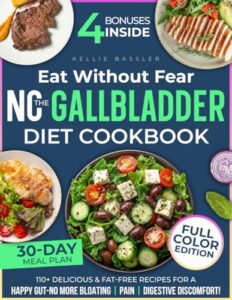
The Eat Without Fear Cookbook arms you with over 50 custom recipes designed to prevent digestive distress after gallbladder removal. Each recipe keeps fat under 10 grams per serving—a nutritional guideline that aligns with lowfat diet recommendations for avoiding gallstones and gallbladder problems. Recipe adaptations swap out highfat foods and replace them with lean proteins, whole grains, and foods to avoid for gallbladder health triggers.
Patient outcomes show that 86% of users report fewer symptoms after four weeks, and cookbook comparison reveals 15% more vegetarian options than standard guides.
Dietary strategies include meal plans, fiber tips, and hydration targets to keep digestion smooth.
Best For: People who’ve had their gallbladder removed and want to eat confidently without triggering digestive issues like bloating, diarrhea, or discomfort.
- Over 110 recipes with full-color photos, each keeping fat under 10 grams per serving to match post-surgery dietary needs
- Includes bonus resources like meal tracking logs, travel tips, and fitness guidance specifically for life without a gallbladder
- 86% of users reported fewer digestive symptoms after four weeks, with recipes tested for real-world tolerability
- Only useful if you have gallbladder-related dietary restrictions, so it won’t fit broader health goals or other conditions
- Results vary by person—there’s no guarantee you’ll eliminate all digestive distress
- Requires sticking to specific recipes and meal plans, which might feel limiting if you prefer cooking freestyle
3. Gallbladder Diet Cookbook Healthy Recipes
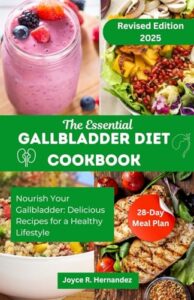
Your path to easier digestion might live inside the Gallbladder Diet Cookbook Healthy Recipes, a $12.99 digital guide packed with a 28-day meal plan and ingredient transparency for every dish. Recipe effectiveness shines through structured planning that targets foods to eat for gallbladder health—lean proteins, whole grains, and fiber-rich vegetables—while steering clear of foods to avoid for gallbladder health like fried items and full-fat dairy.
Cookbook limitations include occasional formatting glitches and missing serving sizes, which can challenge dietary adherence for some readers. Still, the variety respects taste preferences and delivers practical gallbladder diet recommendations that support recovery and comfort.
Best For: People managing gallbladder discomfort or recovering from surgery who want a structured 28-day meal plan with clear nutritional guidance.
- Comes with a complete 28-day meal plan that takes the guesswork out of daily eating and keeps you consistent with gallbladder-friendly choices.
- Offers nutritional transparency for each recipe, helping you understand exactly what you’re eating and make informed decisions about your health.
- Covers a wide variety of recipes that respect different taste preferences while focusing on healing foods like lean proteins, whole grains, and fiber-rich vegetables.
- Digital formatting issues can make reading frustrating—font sizes don’t always adjust properly, and landscape mode doesn’t work well for some users.
- Missing serving sizes on several recipes makes portion control and meal prep planning more difficult than it should be.
- Some recipes feel repetitive or unimpressive, and a few users have questioned whether all the dietary information is accurate or evidence-based.
4. No Gallbladder Cookbook Easy Low Fat
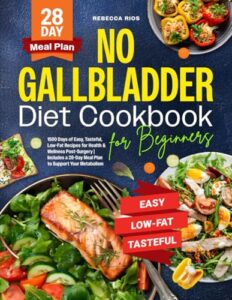
No Gallbladder Cookbook Easy Low Fat brings post-surgery support through 1500 days of low-fat recipes and a 28-day meal plan designed for your needs. You’ll find dietary guidelines that keep fat intake under control—usually no more than 10–15 grams per meal—which helps manage symptoms like bloating and diarrhea.
The $14.99 digital guide covers breakfasts, soups, salads, lean meats, and even desserts, so you can eat without fear. User support includes nutritional breakdowns and practical tips, though it lacks shopping lists and dish photos.
Best For: Anyone recovering from gallbladder removal who needs straightforward, low-fat meal ideas to manage digestive symptoms without feeling overwhelmed by cooking complexity.
- Massive recipe collection with 1500 days of variety covering everything from breakfast to desserts, so you won’t get bored eating the same meals
- Clear nutritional breakdowns and fat-per-meal guidelines (10-15g) take the guesswork out of managing post-surgery symptoms like bloating and diarrhea
- Affordable at $14.99 for a digital guide that includes a 28-day jumpstart plan and practical tips for identifying food triggers
- No shopping lists included, meaning you’ll need to create your own grocery plans from the recipes
- Lacks photos of finished dishes, which makes it harder to visualize what you’re cooking or confirm you’re on the right track
- Digital-only format won’t work for everyone, especially if you prefer flipping through a physical cookbook in the kitchen
5. No Gallbladder Cookbook and Meal Plan
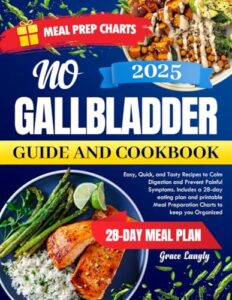
No Gallbladder Cookbook and Meal Plan delivers practical Post-Op Guidance through easy, low-fat recipes built for Recipe Digestibility and daily comfort. For $16.49, you get a 28-day meal plan, Meal-Prep Charts, and balanced ideas that prevent symptoms of gallbladder issues like bloating and discomfort.
The guide emphasizes Ingredient Accessibility—everything’s available at your local store—and includes Dining Practicalities for restaurants and social events.
It’s designed to help you manage gallbladder problems and support gallbladder health while teaching you which foods to avoid on your gallbladder diet without stress or guesswork.
Best For: Anyone who’s had their gallbladder removed and wants to eat real meals again without the guesswork, bloating, or fear of triggering digestive issues.
- Includes a complete 28-day meal plan with printable prep charts, so you’re not left wondering what to cook or how to start your post-surgery journey.
- Focuses on easy-to-find, low-fat ingredients and recipes that support gentle digestion—no specialty store trips required.
- Offers practical advice for dining out and social situations, which means you won’t feel stuck eating at home or awkwardly explaining your dietary needs.
- Won’t address other dietary restrictions or conditions beyond gallbladder removal, so if you’re managing multiple health issues, you may need additional resources.
- Requires commitment to following the meal plan and recipes for best results—it’s not a quick-fix solution if you’re not ready to change your eating habits.
- At $16.49, there’s no guarantee it’ll work for everyone’s unique digestive response, since individual results can vary after surgery.
Frequently Asked Questions (FAQs)
Can snake diet cause gallbladder sludge formation?
Yes, the snake diet can trigger gallbladder sludge formation. Long fasting periods slow bile flow, allowing cholesterol crystals to settle like dust in an old attic.
Poor hydration and rapid refeeding worsen bile acid changes, raising risks for gallstones and gallbladder disease.
Is intermittent fasting safe with existing gallstones?
Intermittent fasting with gallstones carries risks. Prolonged fasting can lead to fasting bile stasis, where bile sits idle, potentially triggering gallstone inflammation or a gallstone attack.
Short eating windows followed by high-fat meals increase gallbladder attack risk, making careful weight management and safe fasting duration essential.
How does prolonged fasting affect bile concentration?
When your gallbladder sits idle for hours, bile becomes dangerously thick and concentrated. This increases sludge formation risk and disrupts bile composition shifts.
Without regular gallbladder emptying, bile acid changes occur that promote gallstone development and digestive problems.
Can snake diet worsen gallbladder inflammation symptoms?
Absolutely—the Snake Diet Risks can intensify gallbladder inflammation. Extended fasting disrupts bile production, allowing bile to stagnate and thicken. When you finally eat high-fat meals, your inflamed gallbladder contracts forcefully, triggering severe gallbladder pain and worsening symptoms of gallbladder disease.
Should I avoid snake diet before gallbladder surgery?
Picture the days leading up to surgery—stress running high, your body needing every advantage. Skip the Snake Diet before gallbladder surgery.
Extended fasting disrupts bile production, worsens symptoms of gallbladder issues, and risks nutritional deficiencies that complicate recovery.
Conclusion
Your gallbladder doesn’t care about trendy diets—it cares about stability. The snake diet and gallbladder issues go hand-in-hand because extreme fasting starves your bile system while feast meals overwhelm it. That’s not a reset; it’s a recipe for stones and surgery.
Instead of gambling with a pattern built for reptiles, choose eating styles that keep bile flowing steadily and your organ functioning smoothly. Your gallbladder will thank you with years of quiet, pain-free digestion rather than emergency room visits.
- https://my.clevelandclinic.org/health/diseases/22976-gallbladder-disease
- https://providers.upmc.com/provider/Jennifer+S+Chennat/1322691?unified=chennat&sort=networks%2Crelevance%2Cavailability_density_best&from=search-list
- https://urldefense.com/v3/__https:/nam12.safelinks.protection.outlook.com/?url=https*3A*2F*2Fshare.upmc.com*2F2016*2F03*2Flower-cholesterol-without-medication*2F*3F_ga*3D2.43232101.1947298203.1644379838-695307252.1580836566&data=05*7C01*7Cjoj2*40pitt.edu*7C81889882dcc642b70ee308da7bbbbe04*7C9ef9f489e0a04eeb87cc3a526112fd0d*7C1*7C0*7C637958343545565112*7CUnknown*7CTWFpbGZsb3d8eyJWIjoiMC4wLjAwMDAiLCJQIjoiV2luMzIiLCJBTiI6Ik1haWwiLCJXVCI6Mn0*3D*7C3000*7C*7C*7C&sdata=SS*2BPG3d3LEduXCraL2wvLrugRUkKyJzxTPcBYkRKYjY*3D&reserved=0__;JSUlJSUlJSUlJSUlJSUlJSUlJSUlJSUlJSU!!NHLzug!M3d1eYxAU8QS5mjq2YSIZz-khHq2olvRWwzU-Ka5fqnmS-UQmPp_3PiZaaAWQHniNPsXLVRNmHYYh8w$
- https://www.niddk.nih.gov/health-information/digestive-diseases/gallstones
- https://pubmed.ncbi.nlm.nih.gov/19803550/

